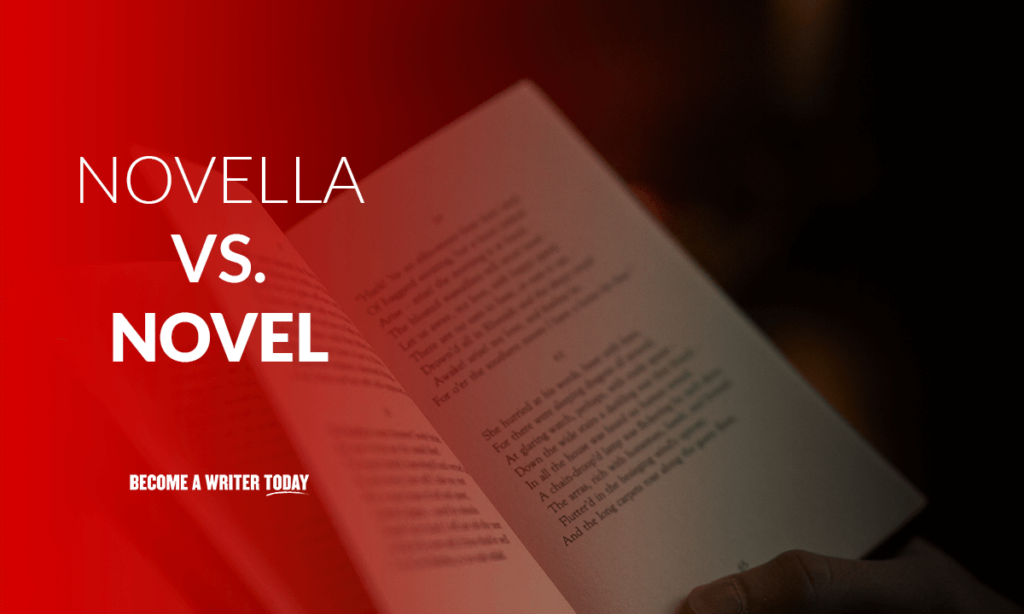Ideal story length is an ongoing debate. Learn how to choose between novella vs. novel and which fits which work is best.
The main difference between a novel and a novella is the average length. Typically, novellas consist of approximately 20,000 to 50,000 words. While there are no strict demarcations, a literary work over 60,000 words is a novel.
| Novella | Novel | |
|---|---|---|
| Length | 20,000 to 50,000 words | 60,000 to 120,000 words (or longer) |
| Plot | Generally more focused, often revolving around a single incident | More complex, involving multiple interconnected incidents |
| Character Development | Limited due to shorter length | Extensive due to longer length |
| Themes | Limited in scope | Covers multiple themes and subplots |
| Reading Time | Can usually be read in one or two sittings | Usually requires multiple sittings to read |
| Examples | Animal Farm by George Orwell, Of Mice and Men by John Steinbeck | Pride and Prejudice by Jane Austen, Moby-Dick by Herman Melville |
Stephen King once described the novella as a failing banana republic, a place where stories go to die slow, unnoticed deaths. But, short-form work is getting more attention in today’s marketplace. Are you debating the ideal length for your story? This article will help you make the right choice.
Contents
A Question of Length: Novella vs. Novel

A novel is longer than a novella. It usually contains more characters, themes, events, and conflicts than a novella. War and Peace by Leo Tolstoy is an example of a lengthy novel that’s hundreds of thousands of words long. Famous examples of novellas include The Old Man in the Sea by Ernest Hemingway and Of Mice and Men by John Steinbeck.
The novella concept originated in Italy during the Middle Ages, whereby authors wrote brief stories about local events. The concept of a novel emerged during the 18th century, where it became easier and cheaper to write and print longer books. Famous novelists from that period include Daniel Defoe, author of Robinson Crusoe, and Jane Austen.
These are, of course, not the only popular forms of fiction. Short stories are published regularly in anthologies, online magazines, and elsewhere. In addition, digital publishing has created a golden age for even shorter works, flash fiction, which often tops at 1,000 words or fewer.
When to Write a Novel
The ideal length for a story depends on many factors. Here are a few questions to ask yourself:
- What is your genre? Science fiction, horror, romance, and young adult genres are more open to shorter works than historical fiction or literary drama.
- Are you looking for a traditional Big 5 publisher? If you have ambitions to score a big contract with one of the big-name publishers, you are more likely to need a higher word count.
- How complex is your story? A long word count will better fit a story with multiple subplots and points of view may. This gives you time for character development and complex plot points.
When a Novella Is a Better Fit

On the other hand, if you are writing for sci-fi, romance, or YA, you will likely find many small publishers eager to get their hands on novellas. These works are especially popular in digital-first publishers. In addition, a novella is a good fit for e-readers because your reader can finish it in a sitting or two.
Certain events and writing prompts fit the novella length better, as well. For example, if you participate in NaNoWriMo and follow the 50,000-word guideline to the letter, you’ll have a reasonably long novella at the end.
Novellas are appreciated by many Amazon Kindle readers, who search the marketplace for self-published genre work. It can take time to build a following, but you can easily publish there regularly if you are creating works around 25,000 words apiece.
Also, a novella might be the length that works best for the story you want to tell. If it is a good story and does not feel rushed at a lower word count, opt for concision and brevity over length. That’s what the best authors like Claire Keegan do. You might also be interested in our subtext vs. context explainer.
Notable Novellas
While there is truth to the idea that novellas are harder to publish, that doesn’t mean there aren’t successes in this form. Franz Kafka’s most famous work, Metamorphosis, clocks in at just over 100 pages. H.G. Wells popularized both time travel fiction and short sci-fi with his 84-page work The Time Machine.
Charles Dickens frequently wrote shorter works of fiction. While he penned several full-length novels, he wrote far more works of 100 pages or fewer. A Christmas Carol is the most famous example. And, for all of King’s grousing about the poor reception of novellas, he’s still contributed at least 20 to the world.
The Final Word on Novella vs. Novel
When it comes to choosing novella vs. novel, considerations about the size of the cast of characters, the complexity of the plot, and the literary genre all come into play. A less complex story might work better as a novella-length work.
On the other hand, a story with deep character development and a convoluted plot may benefit from a longer page count. Choose the one that feels best with the story you are developing.
FAQs about Novella vs. Novel
What is the word count for a novella?
There is no set rule, but a novella is typically between 20,000 and 50,000 words.
What is the origin of the word “novella”?
It was coined in the early 20th century and came from the Italian word for novel.
Is there any difference between a novella and a novelette?
These terms are all used loosely. For example, some people consider novelette and novella synonyms. Others say that a novelette is an even shorter work, often between 8,000 and 17,000 words. Look at the markets you are interested in to determine the definition they use.